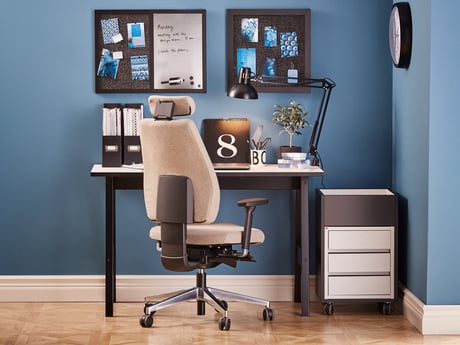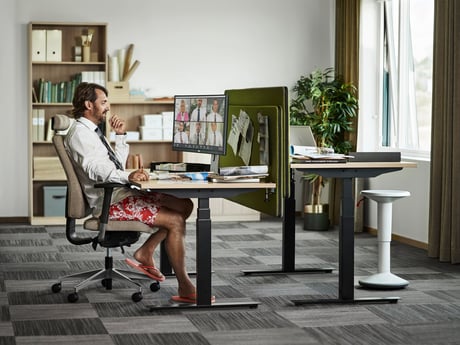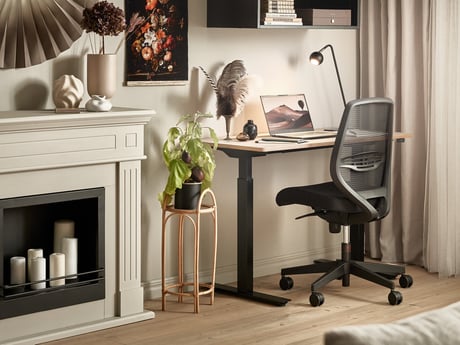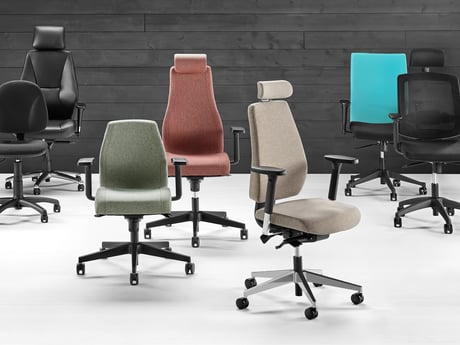- AJ Products UK
- Blog: Tips to Inspire Happiness at Work
- Improving the work environment
- How to create the perfect home office
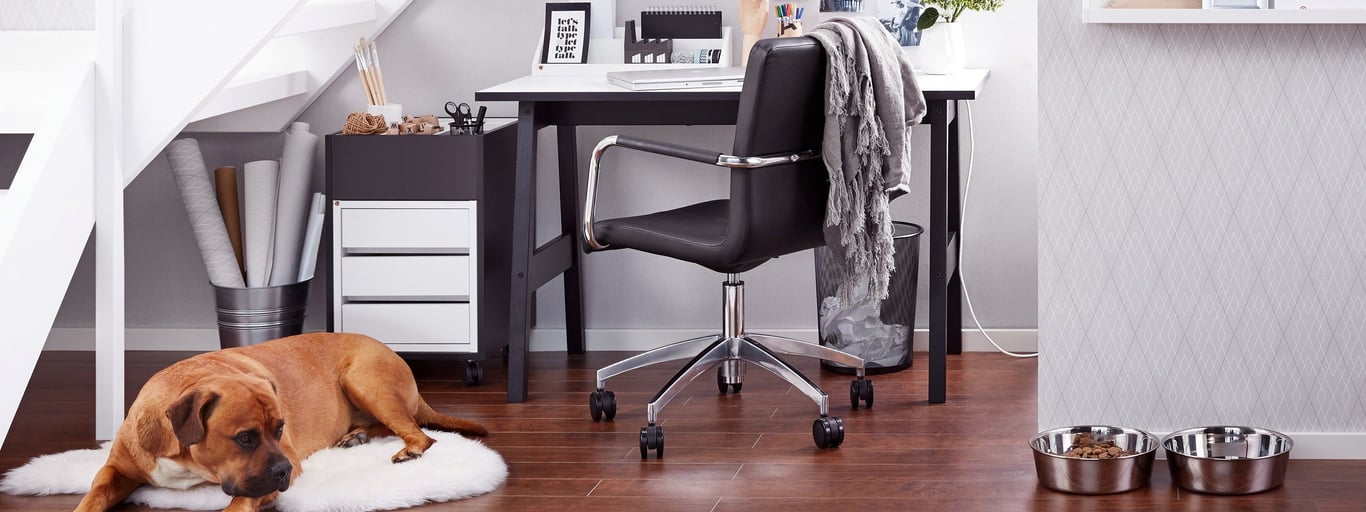
How to create the perfect home office for comfort, health and productivity
There are many advantages to this arrangement: no commute, flexible schedule and a more relaxed way of working, while from a business perspective it has been shown to increase employee morale and productivity. But there can be drawbacks. It can be hard to draw a line between worktime and free time. You also must avoid distractions and keep yourself motivated and focused.
Setting up a dedicated home office is the best way to separate your professional life from your personal one. With the right setup, you can enhance comfort, focus and wellbeing giving you a dedicated space in which to work and to walk away from at the end of the day.
From office furniture, storage and equipment to atmosphere, lighting and practicalities, these handy tips will help you create the perfect home office.
What do you need in your home office?
1. Create a dedicated workspace
A home office often has to fit in whatever space is available and you don’t need a huge amount of space to make it possible. The most important thing is to create a dedicated workspace so you can keep your office separate from your living space, no matter how you do it. Ideally, it should be a separate room that you can close off from the rest of the house and use for work only. Of course, this isn’t always possible; if you have limited space, consider the area under the stairs or even an unused built-in wardrobe!
2. Choose flexible, space saving office furniture
How do you like to work? One of the benefits of setting up a workspace at home is that you can choose your own office furniture and tailor it to create the perfect solution for you. Choose furniture that adapts to different tasks and gives you the space you need to work; your requirements will depend on the type of job you do, whether you’ll have visitors to your office and, of course, your personal preference.
Home office furniture should be space-saving and practical while still giving you a space you want to work in — and one that complements the rest of your home. A compact desk is a brilliant choice, allowing you to tuck it neatly away at the end of the day. Think about whether you’d benefit from built-in storage to hide paperwork, or a minimalist surface that keeps your area uncluttered.
3. Prioritise ergonomic support
Just as in a normal office, you will be sitting down to work in your home office for numerous hours each day. It’s essential to have an office chair that will give you the right support and help you sit in an ergonomic position. Investing in a good ergonomic office chair will prevent back pain, circulation issues and other health complaints as well as lasting far longer than a cheap task chair.
There is no "one size fits all" when it comes to office chairs but there are some key features to look out for to ensure your chair offers good ergonomic support:
- Look for adjustable seat height and backrest.
- Ensure there’s lumbar support to maintain the natural curve of your spine.
- Armrests and tilt functions provide extra comfort.
- If you prefer a more active setup, wobble stools or balance balls are great affordable alternatives that encourage movement.
Remember, no single chair suits everyone, choose the model that feels best for your body. Want help choosing? Find out more about how to choose the right office chair.
4. Convenient storage solutions
A clutter-free space makes it easier to concentrate. Think about what reference materials you need to be able to access and weigh that against the amount of space you have available. Make the most of vertical space by using wall mounted storage solutions and floating shelves. Don’t forget the space underneath your desk: a mobile pedestal or even a small filing cabinet will fit under your desk while still leaving enough space for your legs. Desk high cabinets, bookcases and drawer units will sit alongside your desk and give you easy-to-access storage as well as additional desktop space or somewhere convenient to put a printer.
5. Efficient equipment
Your home office needs to be just as efficient and well-connected as an office building would be. Invest in fast and up-to-date technology. Think about what capabilities your computer and phone need to have and make sure you get professional versions of software packages. Ensure your internet connection is fast enough for your needs and upgrade if necessary. Remember that the time you save from having efficient equipment and good connectivity will soon offset any initial expenditure.
6. Get the lighting right
Good lighting makes a massive difference. Natural light is always the best option - it will help you to stay focused, awake and productive - so try to position your desk near a window if possible. However, your room should also have sufficient overhead lighting that you don’t have to rely on daylight. A desk light will make working in the evenings easier, particularly through those dark winter months. To avoid eye strain, avoid glare by positioning your monitor perpendicular to windows to ensure that lights don’t shine directly onto your computer screen.
7. Keep cables organised
You’d be surprised how much time you’ll save down the line if you take the time to get cables under control when you first set up your home office. Invest in a cable tray that fits to the underside of your desk as well as cable ties and desktop cable holders. Label all your wires so you know what’s what. Opt for wireless devices as much as possible such as a wireless keyboard, mouse and networked printer. Going wireless gives you more flexibility as well as keeping your office tidier and more organised.
8. A noticeboard, notebook and stationery
Old-fashioned it may be but making physical notes can help you remember things better and it’s always handy to have a pen and paper around for jotting down quick reminders. Use a small noticeboard to pin up reminders, hang a calendar and display photos.
9. A sit-stand desk
Given that working from home often means the walking or cycling you might have done as part of your commute is eliminated, it’s important to build some light movement into your day. Standing at your desk is a great start. Being able to vary your position as you work can make a big difference to your overall health and wellbeing.
As the name suggests, a sit-stand desk lets you sit for part of the day and then stand for part of it, making it easy for you to switch between the two throughout your working hours and helping to alleviate back pain and reducing the health risks associated with sitting for long periods.
When setting up your workspace, make sure your screen is positioned correctly. A laptop gives you flexibility to move around the house, but slouching over it can quickly lead to neck and shoulder pain. The solution may be a portable laptop stand — a simple tool that lifts your screen to eye level and prevents strain caused by looking down constantly. Ideally, use a separate screen, mouse and keyboard so that you can maintain a comfortable posture whether sitting or standing. A monitor arm or desk converter is a worthwhile long-term investment that makes height adjustment effortless.
To make the most of your sit-stand setup, consider adding a balance board or active standing desk mat to encourage subtle movement as you stand. Electric sit-stand desks are now more affordable than ever, making them an easy way to add variety and movement into your workday.
10. Add personality, without clutter
When you work from home it’s tempting to surround yourself with home comforts but it’s important to get the right balance between casual home working and a professional space that fosters productivity. Give the space a personal feel with artwork, family photos and houseplants, but don’t clutter the room, use it for general storage or include anything that may distract you. Your home office should be a separate space from the rest of your house: both physically and psychologically. Think about the colours you use because this can have an effect on your mood and energy levels: monochrome is peaceful and free from distractions, blues inspire creativity while bright colours sharpen the memory and make you more active. Don’t be afraid to add a touch of colour and put your stamp on the place!
11. Keep moving at your desk
Make your home office work harder by combining it with your fitness routine. A desk bike is a clever way to stay active while working - it’s designed without handlebars so you can sit comfortably, type easily and maintain a steady pace to boost circulation. Many models track your speed, distance and calories, helping you stay motivated throughout the day.
For an alternative active seating option, try a Pilates ball chair. The constant micro-movements help build core strength and improve posture by keeping your body engaged. Sitting with your feet flat on the floor also promotes better circulation compared to a standard chair. Want to take it further? Add simple desk-based exercises to your routine for an extra fitness boost.
12. Take regular breaks and move through the day
Even with the best ergonomic setup, it’s important to step away from your desk regularly. Without a traditional office routine, it’s easy to stay glued to your screen for hours. But taking short, active breaks can improve focus, reduce eye strain and support your overall wellbeing.
Set a timer to remind yourself to stand, stretch or take a quick walk every hour. Use phone calls as an opportunity to move around the house, or take your lunch break outside for a change of scenery. Even five minutes of movement can help refresh your mind and body so you return to your desk feeling ready to tackle the next task.
